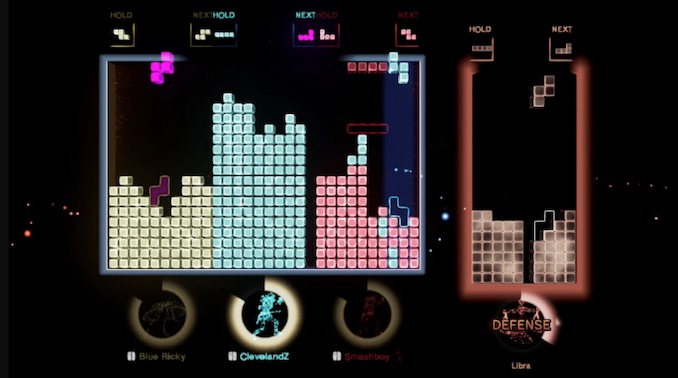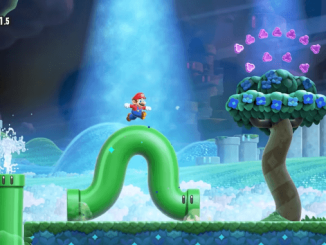Our review of Tetris Effect: Connected, developed by Monstars, Resonair and Stage Games. Released on October 8, 2021 for Nintendo Switch. (Also available on Xbox X/S, Xbox One, PC, and as a free upgrade to the original PS4 Tetris Effect.)

WHAT IS IT?
Tetris by way of rhythm game: same gameplay, with a kaleidoscopic audio-visual backdrop.
IS IT GOOD?
It is the best Tetris you will ever play, but it might be overwhelming for some.
WHY SHOULD PLAY IT?
Anyone who likes Tetris, music, and/or hallucinogens. People who played the original Tetris Effect will appreciate the improved multiplayer modes.

DROP THE BEAT
I am bad at Tetris. I’ve always suspected it, those viral videos of 12-year-old kids playing Tetris at inhuman speeds suggesting that maybe, just maybe, my video game talents lie elsewhere.
Tetris Effect: Connected, the hallucinogenic re-release of a PS4 insta-classic, only reinforces my suspicions. Even after countless hours in the world of Tetris Effect on Switch and PS4, it’s clear I still have much to learn about the placement of falling tetrominoes (or as this game insists on calling them, tetriminoes). It’s sad realizing you’ll never be that good at something.
And yet, Tetris Effect is freaking awesome.

LIGHT IT UP
The first thing you’ll notice about the new Tetris is that it is trying very, very hard to distract you. The tetrominoes are made up of odd shapes and bright colours. There’s a huge screen-obscuring explosion every time you clear a line. In the background of every level, there’s a beautiful and extravagantly animated scene, with fully rendered landscapes, buildings, and creatures, not to mention abstract shapes, fractals, and kaleidoscopic imagery cascading into infinity.
This isn’t Tetris as game. This is Tetris as hallucinatory journey.

CUE THE MUSIC
The next thing you’ll notice, once you’ve gotten accustomed to and embraced the wild visuals, is the music.
That familiar Tetris tune? Gone. In its stead, each level features a unique tune that bops right along to the rhythm of play. The music speeds up as the tetrominoes fall faster, modulates and adds new instrumentation as you progress, and dynamically responds to each button press. The visuals follow the music, too: for every beat in a song, for every line-clear, the background will pulse, shift, react.
In some levels, it might be as simple as crystalline objects popping into and out of existence at the press of a button. In others, it’s the spin of a virtual windmill in time with a violin’s crescendo, or a space whale twirling through the sky, in a sly nod to this game’s predecessor Child of Eden. Screenshots, as impressive as they are, hardly do this game justice: this is a game of motion and of music. With headphones in, it’s a fully-immersive audio-visual experience. Touch, too, for that matter: not only does the controller vibrate in time to the beat, the new Switch version has an “Extra Rumble” feature – it definitely brings more bounce to the experience, though some may find it a bit much. (Happily, it’s optional.)

FEEL THE RHYTHM
Synaesthesia is the simultaneous experience of multiple senses in one moment. It’s a real medical condition, but as an art philosophy it refers to sculptures that hum, organs that project light, the Disney classic Fantasia, and, increasingly, video games.
Especially those of Japanese auteur Tetsuya Mizuguchi, the brains behind Tetris Effect, and a host of similarly hallucinogenic rhythm-based games. He created two of my favourites – Rez, a “rhythm-shooter” masterpiece, and Child of Eden, an early and still leading example of full-body motion control on the Xbox Kinect. Mizuguchi also created the puzzle game Lumines, which is Rhythm Tetris in all but name, and it’s surprising it took this long for him to get a crack at the real thing. Of course, Mizuguchi also re-released Lumines in a version heavily inspired by Tetris Effect, and which I highly recommend players check out.
Tetris Effect: Connected feels like the best parts of Tetris and Lumines combined. That’s especially true for its new multiplayer modes, which include welcome variations on the classic “Tetris Attack” competitive mode. There’s nothing better than clearing a Tetris on your screen, then watching your opponent’s screen blow up in a cascade of technicolour pixels.

EMBRACE THE INFINITE
The first time you plug into Tetris Effect: Connected, it can be overwhelming, your senses flooded with sights and sounds (and “Extra Rumble”). And yet, by inundating you with sensory overload, Tetris Effect actually forces you to focus more. You dig in, thumbs tense, eyes narrowed, and let the game take hold.
I don’t know how a real synaesthete “hears” colour, but I do know that, when the music is flowing, the lights are flashing, the blocks are falling, and the controller is thumping, I’m drawn deeper and further into this particular game than I’ve ever been before.
I’m still bad at it, but Tetris is a hell of a drug.
***
Final score: 9/10 tetrominoes.
Visit the official page for Tetris Effect: Connected here.



